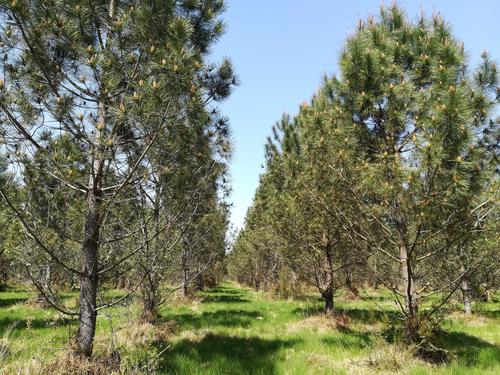
ALIA Ricardo
- Dpt. Forest Ecology and Genetics, INIA, Madrid, Spain
- Population dynamics, genetics and genomics of forest trees
- recommender
Recommendation: 1
Review: 1
Recommendation: 1

Pollen contamination and mating structure in maritime pine (Pinus pinaster Ait.) clonal seed orchards revealed by SNP markers
New insights in seed orchards pollen contamination, study case in an advanced breeding program
Recommended by Ricardo Alia based on reviews by Eduardo Notivol and 1 anonymous reviewerThis preprint (Bouffier et al, 2023) analyses different biological (tree genotype, age, flowering phenology) and environmental factors (vicinity with external pollen sources, orchard structure, soil type, climatic conditions) with influence on the of seed lots in seed orchards of an important forest tree species (Pinus pinaster Ait.). The analysis is based on an optimized set of 60 SNP markers that constitute a new tool for characterizing improved material in the breeding program of the species.
One of the main questions when managing seed orchard is to obtain a precise estimation of pollen contamination, as it causes major losses to genetic improvement from selection and breeding (Di Giovanni and Kevan, 19911) but also will determine the adaptive potential of the species (Kremer et al. 2012). The results indicate that contamination rates were highly variable between seed lots (from 20 to 96%), with a mean value of 50%). The main factors determining these rates include the distance between the seed orchard and external pollen sources, rain during the pollination period, seed orchard age, soil conditions and seed parent identity.
A second point of interest in this paper is the determination of the overall self-fertilization rate. This factor also determines the quality of the seed-lots and was estimated as 5.4%, with high variability between genotypes (from 0% to 26%). The overall value is of the same order of magnitude than in other species.
These results are used to define some recommendations for managing seed orchards in the French breeding program, but that can be generalized to other species (eg. Mullin and Lee, 2013). As an example, they recommend that sampling 100 seeds annually should be sufficient to estimate pollen contamination (with a standard error of 5%). Also, they suggest that one of the main measures to reduce pollen contamination is carefully selecting the location of the orchard, in terms of its distance from external pollen sources and soil conditions, and not collecting seeds from young trees (below 8 years old).
The present preprint revisits an important topic of research with interest for the biology of tree species, but also with great implications in applied breeding activities. The main conclusions are essential to understand the importance of different factors in managing seed orchards and in the future performance of the reproductive material.
In conclusion, this paper stresses the need for more studies, taking advantage of new genomic tools, to advance the knowledge of factors influencing the success of breeding programs.
REFERENCES
Bouffier L, Debille S, Alazard P, Raffin A, Pastuszka P, Trontin JF (2023). Pollen contamination and mating structure in maritime pine (Pinus pinaster Ait.) clonal seed orchards revealed by SNP markers. bioRxiv, 2022.09.27.509769, ver. 2 peer-reviewed and recommended by Peer Community in Forest and Wood Science. https://doi.org/10.1101/2022.09.27.509769
Di-Giovanni F, Kevan PG (1991) Factors affecting pollen dynamics and its importance to pollen contamination: a review. Can J For Res 21(8):1155-1170.
https://doi.org/10.1139/x91-163
Kremer A, Ronce O, Robledo-Arnuncio JJ, Guillaume F, Bohrer G, Nathan R, Bridle JR, Gomulkiewicz R, Klein EK, Ritland K, Kuparinen A, Gerber S, Schueler S (2012) Long-distance gene flow and adaptation of forest trees to rapid climate change. Ecol Lett 15(4):378-92.
https://doi.org/10.1111/j.1461-0248.2012.01746.x
Mullin TJ, Lee SJ (2013) Best practice for tree breeding in Europe. Skogforsk, Uppsala, Sweden. ISBN: 530 978-91-977649-6-4. https://www.skogforsk.se/contentassets/42acda01f83843bf925f690bd0a6ed37/best-practice-hela-low.pdf
Review: 1

High-quality SNPs from genic regions highlight introgression patterns among European white oaks (Quercus petraea and Q. robur)
A new resource for a better understanding of the complex genetic dynamics within the oak syngameon
Recommended by Erwin Dreyer based on reviews by Oliver Brendel, Ricardo Alia, Komlan Avia and Hilke SchröderWhen we launched the multidisciplinary PCI Forest and Wood Sciences, we were well aware that this PCI devoted to a broad object (forests represent 1/3 of the emerged land area) and gathering multiple disciplines (from biology to social sciences), would be confronted with some challenges with respect to the range of pre-prints we would have to consider. Among the first ones submitted to the new PCI was this very interesting one (Lang et al, 2021) in the area of tree genomics and tree population genetics with a strong background in bioinformatics. This could well have been submitted to the PCI in Genomics, or the PCI in Evolutionary Biology, but finally fits very well in PCI Forest and Wood Sciences due to its finality: provide reliable genomic resources to tackle questions that are central to our understanding of the dynamics of forest ecosystems and the adaptation of trees to local conditions.
The phylogenetic status of the two sympatric oak species Quercus robur L. and Q. petraea Matt. Liebl. is an important question that was the center of in depth investigations by the BioGeCo research group at Bordeaux in cooperation with many European groups. The two species are major forest tree species in western Europe, structuring important ecosystems and providing high quality wood and other important ecosystem services. These species are considered to build up what is now called a “syngameon” together with a few other western European white oaks (Cannon and Petit, 2019). A syngameon is a complex of species exchanging genes, while still maintaining some degree of interspecific diversity enabling to differentiate, on the basis of leaf morphology for instance, the originally described species (Kremer et al, 2002 among many others dealing with the identification of oak species on the basis of their phenotype). The full sequencing of the genome of Q. robur (Plomion et al, 2018) opened an avenue for the development of new genomic tools to investigate the concept of species in this syngameon and to identify gene flows between populations and species. To date, whole genome sequencing and annotation is completed for Q. robur, Q. lobata Née, Q. suber L., and Fagus sylvatica L. (Plomion and Martin, 2020).
The preprint of Lang et al (2021) builds up on this background and provides a very interesting and important contribution to this area. First, it provides access to a very large data base of genomic sequences, based on 800 gene fragments and identified 12500 Single Nucleotide Polymorphisms (SNPs) as well as 1500 insertions deletions. 11 individuals assigned to the species Q. robur, 13 assigned to Q. petraea and 1 to Q. ilex L. were used to establish this data base. This is an important asset for developing future research on species identification based on their genomes. In full agreement to the policy of all PCIs about data availability, full access is provided to the data under a free use license CC-BY.
The manuscript has already a long history as a preprint and it was not that easy to find reviewers willing to do the job of reviewing such a large amount of information with a lot of technical details. At the end, we succeeded and obtained three very enthusiastic and positive reviews (attached to this recommendation). All reviewers agreed that this was an important contribution in the field, insisted on the quality of the writing and of the provided data, and finally agreed that the manuscript was to be recommended after a careful revision. The revision was readily done by the authors. One of the reviewers found that the preprint is close to a “data paper”, i.e., a paper providing the required information to enable (and advertise) the reuse of an important data set, which is only partly true. Indeed, the authors nicely used their data to address one of the most debated questions about the population genetics: how comes that in this syngameon, with inter-fertile individuals, clearly distinguishable species (from the phenotype at least) have been maintained?
The main result of the preprint is that indeed there are some (only few) genomic differences among the two species in the patterns of distribution of the SNPs, but also that the patterns reveal a clear introgression of the genome of one of the species into the other one. This was based on a Bayesian clustering analysis reported figure 3, evidencing that 2 individuals displaying an unambiguous Q. petraea phenotype could not be assigned to any of the species. The usual hypothesis postulates an introgression of the Q. robur genome, the pioneer species able to colonize open areas during the post-glacial recolonization into that of Q. petraea, due to hybridization and successive events of back gross with inflowing Q. petraea pollen. Such an introgression was hypothesized decades ago, and receives here some degree of confirmation. Recent findings showed the importance of such an introgression for the adaptation of local oak populations to altitudinal gradients (Leroy et al, 2020).
Given the importance of the contribution (both from the point of view of the development of new genomic tools and from that of our understanding of the population genetics in the oak syngameon, I do recommend this preprint in the frame of the PCI Forest and Wood Sciences after an insightful peer reviewing and a very careful revision leading to the current version 4 of this preprint.
References
Cannon CH, Petit RJ (2020) The oak syngameon: more than the sum of its parts. New Phytologist, 226, 978–983. https://doi.org/10.1111/nph.16091
Kremer A, Dupouey JL, Deans JD, Cottrell J, Csaikl U, Finkeldey R, Espinel S, Jensen J, Kleinschmit J, Dam BV, Ducousso A, Forrest I, Heredia UL de, Lowe AJ, Tutkova M, Munro RC, Steinhoff S, Badeau V (2002) Leaf morphological differentiation between Quercus robur and Quercus petraea is stable across western European mixed oak stands. Annals of Forest Science, 59, 777–787. https://doi.org/10.1051/forest:2002065
Lang T, Abadie P, Léger V, Decourcelle T, Frigerio J-M, Burban C, Bodénès C, Guichoux E, Provost GL, Robin C, Tani N, Léger P, Lepoittevin C, Mujtar VAE, Hubert F, Tibbits J, Paiva J, Franc A, Raspail F, Mariette S, Reviron M-P, Plomion C, Kremer A, Desprez-Loustau M-L, Garnier-Géré P (2021) High-quality SNPs from genic regions highlight introgression patterns among European white oaks (Quercus petraea and Q. robur). bioRxiv, 388447, version 4 peer-reviewed and recommended by PCI Forest and Wood Sciences. https://doi.org/10.1101/388447
Leroy T, Louvet J-M, Lalanne C, Provost GL, Labadie K, Aury J-M, Delzon S, Plomion C, Kremer A (2020) Adaptive introgression as a driver of local adaptation to climate in European white oaks. New Phytologist, 226, 1171–1182. https://doi.org/10.1111/nph.16095
Plomion C, Aury J-M, Amselem J, Leroy T, Murat F, Duplessis S, Faye S, Francillonne N, Labadie K, Le Provost G, Lesur I, Bartholomé J, Faivre-Rampant P, Kohler A, Leplé J-C, Chantret N, Chen J, Diévart A, Alaeitabar T, Barbe V, Belser C, Bergès H, Bodénès C, Bogeat-Triboulot M-B, Bouffaud M-L, Brachi B, Chancerel E, Cohen D, Couloux A, Da Silva C, Dossat C, Ehrenmann F, Gaspin C, Grima-Pettenati J, Guichoux E, Hecker A, Herrmann S, Hugueney P, Hummel I, Klopp C, Lalanne C, Lascoux M, Lasserre E, Lemainque A, Desprez-Loustau M-L, Luyten I, Madoui M-A, Mangenot S, Marchal C, Maumus F, Mercier J, Michotey C, Panaud O, Picault N, Rouhier N, Rué O, Rustenholz C, Salin F, Soler M, Tarkka M, Velt A, Zanne AE, Martin F, Wincker P, Quesneville H, Kremer A, Salse J (2018) Oak genome reveals facets of long lifespan. Nature Plants, 4, 440–452. https://doi.org/10.1038/s41477-018-0172-3
Plomion C, Martin F (2020) Oak genomics is proving its worth. New Phytologist, 226, 943–946. https://doi.org/10.1111/nph.16560